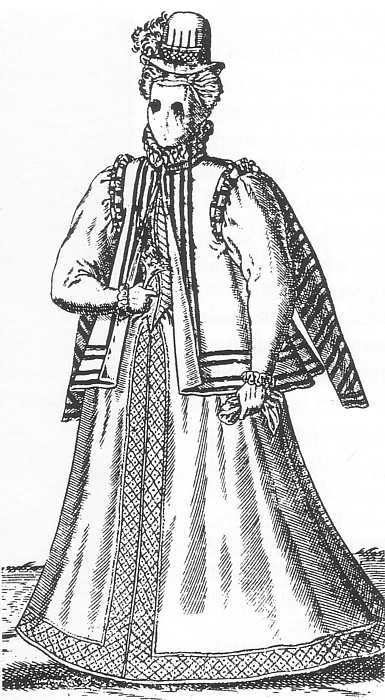Visard on:
[Wikipedia]
[Google]
[Amazon]


 A visard (also spelled vizard) is an oval mask of black velvet, worn by travelling women in the 16th century to protect their skin from sunburn. The fashion of the period for wealthy women was to keep their skin pale, because a tan suggested that the bearer worked outside and was hence poor. Some types of vizard were not held in place by a fastening or ribbon ties, and instead the wearer clasped a bead attached to the interior of the mask between their teeth.
The practice did not meet universal approval, as evidenced in this excerpt from a contemporary polemic:
In
A visard (also spelled vizard) is an oval mask of black velvet, worn by travelling women in the 16th century to protect their skin from sunburn. The fashion of the period for wealthy women was to keep their skin pale, because a tan suggested that the bearer worked outside and was hence poor. Some types of vizard were not held in place by a fastening or ribbon ties, and instead the wearer clasped a bead attached to the interior of the mask between their teeth.
The practice did not meet universal approval, as evidenced in this excerpt from a contemporary polemic:
In
Details of a visard
in the collection of the Norwich Castle Museum
A miniature visard made for a 17th-century child's doll
in the collection of the Victoria and Albert Museum __NOTOC__ 16th-century fashion 16th century in Europe 17th-century fashion 17th century in Europe History of clothing (Western fashion) Masks {{Europe-hist-stub


 A visard (also spelled vizard) is an oval mask of black velvet, worn by travelling women in the 16th century to protect their skin from sunburn. The fashion of the period for wealthy women was to keep their skin pale, because a tan suggested that the bearer worked outside and was hence poor. Some types of vizard were not held in place by a fastening or ribbon ties, and instead the wearer clasped a bead attached to the interior of the mask between their teeth.
The practice did not meet universal approval, as evidenced in this excerpt from a contemporary polemic:
In
A visard (also spelled vizard) is an oval mask of black velvet, worn by travelling women in the 16th century to protect their skin from sunburn. The fashion of the period for wealthy women was to keep their skin pale, because a tan suggested that the bearer worked outside and was hence poor. Some types of vizard were not held in place by a fastening or ribbon ties, and instead the wearer clasped a bead attached to the interior of the mask between their teeth.
The practice did not meet universal approval, as evidenced in this excerpt from a contemporary polemic:
In Venice
Venice ( ; it, Venezia ; vec, Venesia or ) is a city in northeastern Italy and the capital of the Veneto Regions of Italy, region. It is built on a group of 118 small islands that are separated by canals and linked by over 400 ...
, the visard developed into a design without a mouth hole, the ''moretta
Moretta is a ''comune'' (municipality) in the Province of Cuneo in the Italian region Piedmont, located about southwest of Turin and about north of Cuneo. As of 1-1-2017, it had a population of 4 141 and an area of .All demographics and other st ...
'', and was gripped with a button between the teeth rather than a bead. The mask's prevention of speech was deliberate, intended to heighten the mystery of a masked woman even further.
A Spanish observer at the wedding of Mary I of England and Philip II of Spain in 1554 mentioned that women in London wore masks, ''antifaces'', or veils when walking outside. In Scotland in the 1590s Anne of Denmark wore masks when horse riding. These were faced with black satin, lined with taffeta, and supplied with Florentine ribbon for fastening and for decoration. At the Union of Crowns in 1603, she travelled to England in June, and it was said she had done "some wrong" to her complexion "for in all this journey she hath worn no mask". In 1620 the lawyer and courtier John Coke sent clothes and costume from London to his wife at Much Marcle
Much Marcle is a village and civil parish in Herefordshire, England, located north-east of Ross-on-Wye. The 2011 Census recorded the parish's population as 660. The name ''Marcle'' comes from the Anglo-Saxon word for a boundary field, ''mearc-l ...
, including a satin mask and two green masks for their children.''HMC 12th report part I, Earl Cowper, Coke'' (London, 1888), p. 108.
Citations
See also
*1550–1600 in Western European fashion
Fashion in the period 1550–1600 in Western European clothing was characterized by increased opulence. Contrasting fabrics, slashes, embroidery, applied trims, and other forms of surface ornamentation remained prominent. The wide silhouette, ...
References
* * * *External links
Details of a visard
in the collection of the Norwich Castle Museum
A miniature visard made for a 17th-century child's doll
in the collection of the Victoria and Albert Museum __NOTOC__ 16th-century fashion 16th century in Europe 17th-century fashion 17th century in Europe History of clothing (Western fashion) Masks {{Europe-hist-stub

